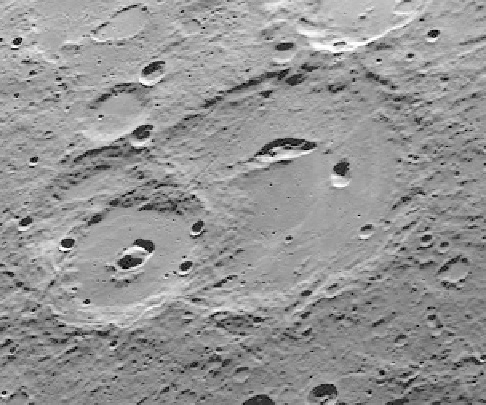Geology Reference
In-Depth Information
Figure 5.29. A volcano and vent complex in the Caloris basin, as
mapped by Head et al.(
2008
), showing a dome or shield structure
and various irregular-shaped depressions (vents). The bright halo is
thought to be a deposit of pyroclastic materials (NASA MESSENGER
EN0108826812M and EN108822877M).
Figure 5.30. An oblique view of irregularly shaped pits on the
oors
of two craters, suggested to represent collapse over magma
chambers; the area shown is about 200 km across (NASAMESSENGER
NAC 162744290, NASA PIA 12284).
compositions low in iron and titanium), accompanied by
local pyroclastic activity. Volcanism on Mercury is set
apart from volcanism on Earth, Venus, and Mars by the
apparent absence of large shield volcanoes.
5.5.5 Tectonic features
Mercury
'
s crust has been subjected to tectonic deforma-
tion that has led to the formation of a variety of surface
features, including scarps and ridges of various shapes,
including arcuate, lobate, and linear forms. Mapping these
features and assessing their ages in relation to the terrain
that they cut can provide clues as to the style and timing of
tectonic processes in different regions of Mercury.
Lobate scarps form tongue-like margins, range in
length from 100 to >1,000 km, and can be as high as
2 km. Although some lobate scarps super
cially resemble
lava
flows, most investigators consider the scarps to be
faults, perhaps controlled by earlier tectonic patterns.
Other scarps are arcuate in planform or consist of short
linear segments.
Figure 5.31
shows Discovery Rupes, a
typical mercurian scarp that cuts across large craters.
Scarps, such as Vostock Rupes, can shorten the circum-
ference of the craters they cut across, suggesting thrust-
fault movement (
Fig. 5.32
).
In general, the various types of scarps are thought to
represent compressional deformation that occurred as
Mercury cooled and shrank. Careful mapping and inde-
pendent analytical modeling resulted in the same
Figure 5.31. Discovery Rupes is more than 500 km long and cuts
across the terrain including craters Rameau (A, 55 km in diameter)
and crater B; the arrow points to a small dome that could be a
volcanic construct (NASA Mariner 10, from Davies et al.,
1976
).
Although conclusions await full analysis of
MESSENGER data, initial results suggest that the style
of mercurian volcanism was similar to that on the Moon in
that it involved massive eruptions of
flood lavas (but with





